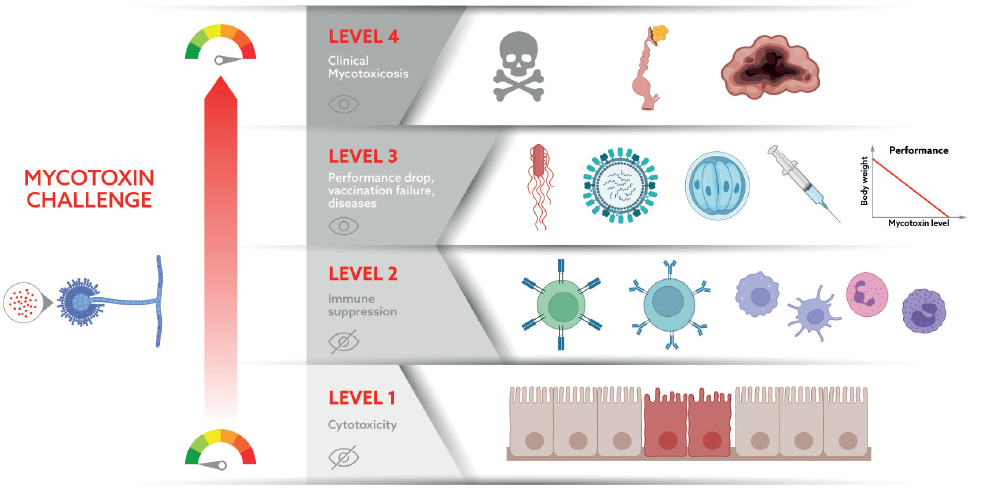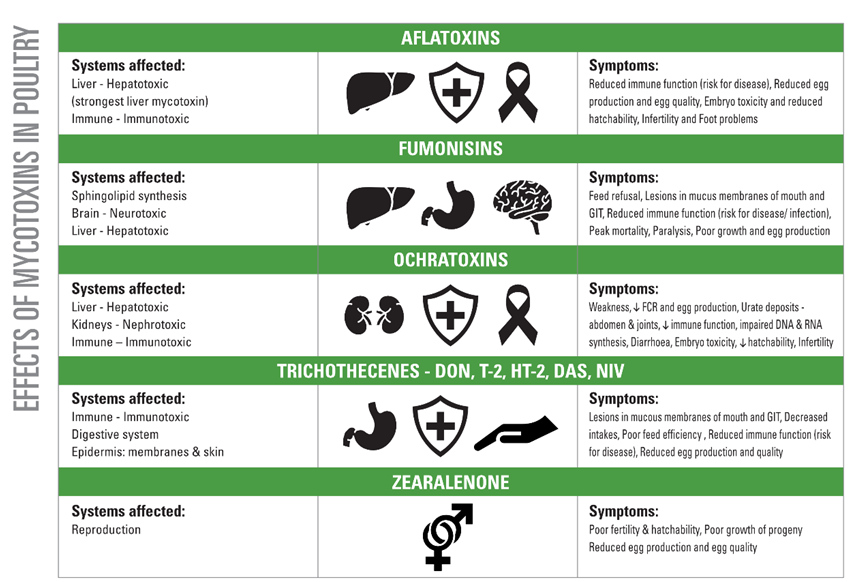Mycotoxins are chemical compounds produced by moulds. These compounds are toxic to animals and humans. Moulds produce mycotoxins as a defensive compound when they are in competition with other organisms or when the moulds are under stress.
Following moulds produce mycotoxins:
When do these moulds produce the mycotoxins?
Mycotoxin facts
- Mycotoxins are invisible, odourless and heat stable.
- The effects of mycotoxins are often subclinical and are not noticed by farmers as a result. Mycotoxins are often only identified and managed after signicant herd production losses have occurred.
- When multiple toxins are present in the feed, increases in negative effects in animals may be observed, due to interactions between toxins and their metabolites.
- Some raw materials have higher risk for specific mycotoxins. High moisture raw materials and feeds have a higher risk for mould growth and thus also a higher risk for mycotoxins. Aflatoxins and Ochratoxins are more often found in protein rich raw materials such as peanuts, cottonseed, soya and maize products and by-products, while Fumonisins are common in maize and maize products for example.
- Mycotoxin occurrence is often seasonal, due to the effect of moisture and temperature on mould growth.
- Factors affecting mycotoxin pathogenicity (animal sensitivity)
- Health & stress levels of the animal
- Age of the animal
- Duration of exposure to mycotoxins
- Passage rate of feed
Only in case of severe significant contaminations, a clinical picture is observed on farm. Nowadays, due to the efficient screening and control of raw materials and feeds, the occurrence of clinical mycotoxicosis is less prevalent. However, the impact of low to medium levels of mycotoxins are not to be neglected. Mycotoxins are cytotoxic, damaging the intestinal barrier, and are immune suppressive leading to a subclinical mycotoxicosis. Poultry will be more susceptible to diseases, vaccine programs could fail, performance drops are a real threat.

Less prevalent due to efficient control.
Compared to pigs, poultry is more resistant against mycotoxins. However, some poultry species are more resistant compered to others: Ducks, geese, and turkeys seem to be more sensitive to mycotoxicosis than chickens and quails. Poultry species intended for breeding and younger animals are more sensitive as well.
Poultry is most sensitive to T-2 and ochratoxin. Zearalenone can be a threat in reproductive poultry.

The above-mentioned mycotoxins are the most known mycotoxins, but next to them, the group of emerging mycotoxins get more attention. The effects of emerging mycotoxins such as beauvericin and enniatin in poultry are less known and need more research.
Of most importance today
Even the smallest amounts of mycotoxins have the ability to impair intestinal health, immune function, and/or pathogen fitness causing altered host-pathogen interactions and in turn, higher susceptibility to disease.
Specifically, fusarium mycotoxins generally exacerbate infections with coccidia and even aspergillus in all poultry species. A predisposition for necrotic enteritis in broilers is shown when mycotoxins, for example, DON or fumonisins, are present in the feed, even at low dosages.
Moreover, feeding chicks with mycotoxin contaminated diets (comprising Don and Fum), increases plasma cortisol levels — a stress hormone — which has a negative effect on poultry welfare overall.
• Prevention of mycotoxin development by preventing mould development on crops as well as during storage of feed and raw materials. Use solutions to prevent mould growth. Monitor mycotoxins in high risk raw materials. Use a mycotoxin solution in feed to protect the animal.
• Management of the mycotoxins present by adjusting formulations. Use low inclusions of materials with high mycotoxin levels.
• Treat the mycotoxin problem by including mycotoxin solutions in the feed.
Interested in our solution to mycotoxin management?
TOXFIN® FARM; is the solution to protect the animal from all mycotoxin threats. It is an all-in-one strategy consisting of clay minerals, plant extracts, and algae beta-glucan to tackle the adverse effects of mycotoxins in animals. Read more on TOXFIN FARM here.© Kemin Industries, Inc. and its group of companies 2026 all rights reserved. ® ™ Trademarks of Kemin Industries, Inc., USA
Certain statements may not be applicable in all geographical regions. Product labeling and associated claims may differ based upon government requirements.